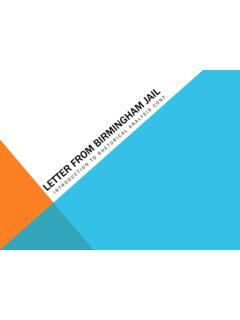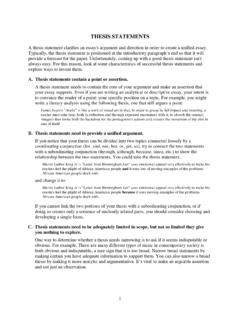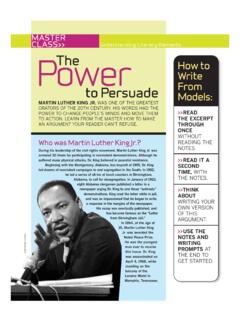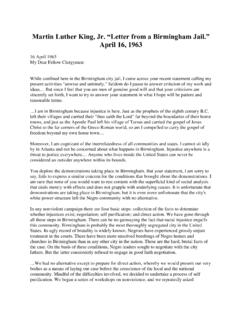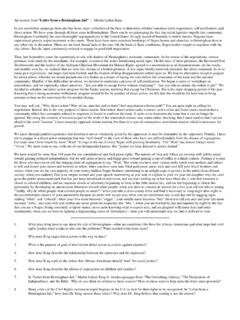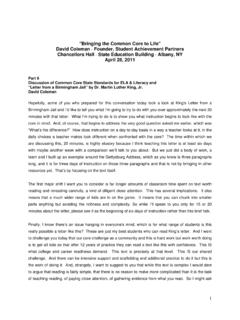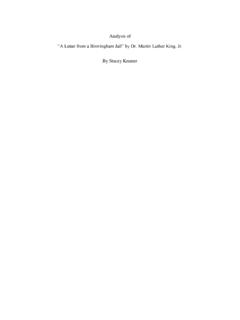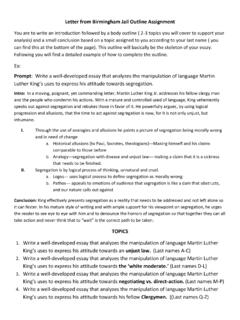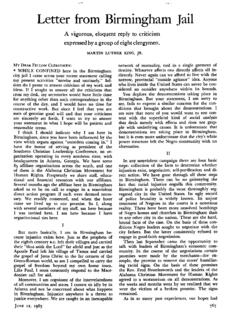Transcription of Critique of Martin Luther King’s “Letter From Birmingham ...
1 Critique of Martin Luther King s letter From Birmingham jail Jessica GarnerBrigham Young University - IdahoRunning Head: Critique OF Martin Luther KING S letter FROM Birmingham jail 1 Summary In Martin Luther King Jr. s letter From Birmingham jail , King, a reverend from the South and the face of the Civil Right s Movement, writes to his fellow clergymen, defending his stance on nonviolent protests, as well as the actions he took in protest against racial injustices. In this letter , King calls for nonviolent action from everyone and especially from religious figures who are near the center of these issues. King claims that nonviolent action is the next step in furthering the civil rights movement. King s reasons for his call for nonviolent action are many. His first reason is that there are four ways to discover the presence of an injustice and they found they were being unjustly treated. King goes from there to explain that there is a difference between just and unjust laws and claims that an unjust law is no law at all and should be fought at all costs.
2 Thus, he calls for action to fight the injustices and establish equality. He then expresses his own personal disappointment in humans for allowing such injustices to happen and explains how this caused him to take action. It is then that he chastises his religious colleagues for not helping more in the cause. He calls them to action by telling them that no one who claims to be Christian can sit idly by and watch injustices happen to their brothers and sisters and then tells them to rise to the cause and begin to fight alongside King himself. He closes his letter reiterating his call for action and the reasons it is necessary and asks all to begin to take action. King s letter is an effective call to action that uses various techniques to convince his audience of the necessity to rise to action. In this Critique , we will discuss the various ways that King effectively used ambiguities, assumptions, logical fallacies and evidence to persuade his audience to agree with his stance.
3 Critique OF Martin Luther KING S letter FROM Birmingham jail 2 Ambiguities Martin Luther King uses many key terms in his letter from Birmingham jail and clearly defines those terms that he uses throughout the letter . Some of the most definitive terms that he uses and explains are non-violent direct action, just versus unjust laws and extremists. King s refutation of ambiguities strengthen his credibility and this persuades readers to agree with King s assertions about the civil rights movement. Firstly, King s letter is based upon the conclusion that nonviolent direct action is needed to further the civil rights movement. However, what does nonviolent direct action mean exactly? King defines for us what he means by nonviolent direct action in the letter when he poses the question to his audience: Why direct action, why sit-ins, marches and so forth? , (King, 1963, p. 214). King defines what he means by nonviolent direct action when he poses this question by giving a short list of acceptable forms of nonviolent actions that may be taken.
4 Through these examples the reader gains a clearer understanding what type of action King is looking for when he requests nonviolent action to further the civil rights movement and helps individuals know what they can do in order to help further the efforts of the civil rights movement. Another term that King definitively states is the terms of just versus unjust laws. King claims in the letter that his people are suffering racial injustices at the hand unjust laws and makes the statement that, An unjust law is no law at all, (King, 1963, p. 216) and should therefore be disobeyed. One may wonder how to know which laws are just and which are unjust though. King removes these doubts from the minds of his readers by defining clearly what just and unjust laws are: An unjust law is a code that is out of harmony with the moral law..an unjust law is a human law that is not rooted in eternal and natural law. Any law that uplifts Critique OF Martin Luther KING S letter FROM Birmingham jail 3human personality is just.
5 Any law that degrades human personality is unjust, (King, 1963, p. 216). King clearly defines what he means by just and unjust laws through this definition, but he further expounds upon the subject by providing multiple examples of just versus unjust laws leaving no doubt in the mind of the reader what he means by his definition. This clear definition helps to further solidify his argument and builds upon King s credibility which helps persuade the reader to believe King and hopefully instill a desire in them to help King in his civil right s cause. The last key term that King clearly defines is that of the term extremist. King defines the term extremist through using positive examples of extremists. King begins by saying that he gained a bit of satisfaction from being considered an extremist, (King, 1963, p. 219) and goes on to compare himself to various people who are also considered extremists: Was not Amos an extremist for justice?
6 Was not Paul an extremist for the gospel of Jesus Christ? ..Was not Martin Luther an extremist? (King, 1963, p. 219). King even goes so far as to compare himself to Jesus Christ claiming that Christ was an extremist in love, (King, 1963, p. 219). These comparisons persuade the reader to agree with King and see that while he may be extreme, he is an extremist for the right side just as these other extremists were and this convinces the reader to agree and follow King in his pursuit of equality. King s definitive terms leave no room for ambiguities and solidifies his argument. His careful avoidance of ambiguities strengthens his argument, builds his credibility and convinces the reader to believe his argument and help in the cause for civil rights. AssumptionsCRITIQUE OF Martin Luther KING S letter FROM Birmingham jail 4 While King readily refutes ambiguities in his argument, he does have a few assumptions that could weaken his argument if a careful reader were to recognize these assumptions.
7 The major assumptions that King makes in his argument are the value assumption that Christians will agree with him simply because they are Christian, and the descriptive assumption that the white moderate values order more than they value justice and he bases some of his argument upon these assumptions. King is a Christian reverend who has strong opinions of how a Christian should conduct themselves. One of the main arguments in his letter , is that anyone who claims to be Christian cannot stand idly by and watch these injustices happen to their brothers and sisters. However, King is functioning under the value assumption that all Christians share his views of Christianity and that they value the same things. King claims that, the judgement of God is upon the church as never before. If the church of today does not recapture the sacrificial spirit of the early church, and join King s convictions for social justice then the church will be dismissed as an irrelevant social club with no meaning, (King, 1963, p.)
8 222). King makes a strong assumption that all Christians have the same level of conviction that he does. This, however, may not be true. A Christian is simply one who claims to believe in Jesus Christ. This does not mean that they will feel the same way as every other Christian, and especially not the same as King because he is a reverend and he has higher standards of Christians because of his own high standards. Thus, King slightly weakens his argument to a careful reader by making such a large assumption and basing a part of his argument off of this assumption. Another assumption that King makes is a descriptive assumption that the white moderate cares more for order than they do for justice. He makes the comment that he is disappointed with Critique OF Martin Luther KING S letter FROM Birmingham jail 5the white moderate who are more devoted to order than to justice, (King, 1963, p. 217). King assumes that the white moderate cares only to keep order and does not care about the goals of the civil rights movement.
9 This, however, may not be true. It is possible that the white moderate is not fully aware of the civil rights movement and all it entails. It is also possible that the white moderate thinks that they have already achieved equality in equal but separate laws. King makes the descriptive assumption that the white moderate cares only about order and not of justice, but it is a possibility that they are not aware, or they think the civil rights movement has already achieved justice and thus, they will not be swayed by King s arguments. This assumption, again to the careful reader, could weaken his argument if they see again that a significant portion of his argument is based upon this assumption. The assumptions that King makes weaken his argument if you read into them carefully and take away from the credibility of the article, but overall, his argument is strong enough to stand up even with these couple of assumptions in it. Logical Fallacies While King s argument may have been slightly weakened by his assumptions, it is effectively strengthened through his use of the logical fallacy of either/or thinking.
10 King uses this logical fallacy to his benefit and persuades his audience to agree with him and his assertion that nonviolent direct action is needed to further the civil rights movement. King effectively uses the either/or logical fallacy firstly to direct his argument. He brings up a letter that he received from a man in Texas. This man wrote to King and questioned whether King was in too great of a religious hurry [to establish civil rights]? [As] It has taken Christianity almost 2000 years to accomplish what it has. The teachings of Christ take time to Critique OF Martin Luther KING S letter FROM Birmingham jail 6come to earth. (King, 1963, p. 218) King uses this statement to support his view that the civil rights movement will not just happen. Time is neutral, (King, 1963, p. 218) King claims and he uses this comment as support to the idea that the time for civil rights is now. He further convinces his audience that not only is the time for civil rights now, but the time for nonviolent action is now as well.
